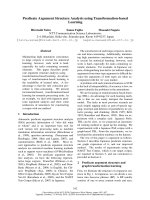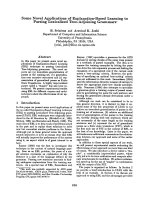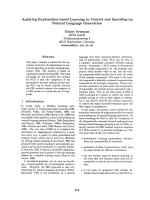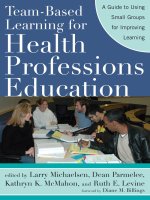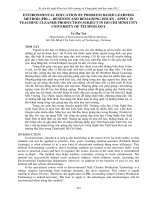Digital game based learning michael burmester, daniela gerhard, frank thissen(bookfi org)
Bạn đang xem bản rút gọn của tài liệu. Xem và tải ngay bản đầy đủ của tài liệu tại đây (9.13 MB, 264 trang )
Michael Burmester, Daniela Gerhard,
Frank Thissen (eds.)
Digital Game Based Learning
Proceedings of the 4th International
Symposium for Information Design
2nd of June 2005 at Stuttgart Media University
Digital Game
Based Learning
Proceedings of the 4th International
Symposium for Information Design
2nd of June 2005 at Stuttgart Media University
Michael Burmester
Daniela Gerhard
Frank Thissen
(eds.)
Impressum
Universitätsverlag Karlsruhe
c/o Universitätsbibliothek
Straße am Forum 2
D-76131 Karlsruhe
www.uvka.de
Dieses Werk ist unter folgender Creative Commons-Lizenz
lizenziert: />Universitätsverlag Karlsruhe 2006
Print on Demand
ISBN 3-86644-010-3
Editorial
Learning and gaming: does this fit together? Can we use the idea of computer games
to make use for learning purposes? Who will benefit from this? Does learner learn
better or more motivated, when they play games in order to acquire content? Is it
more fun to learn by games? According to Marc Prensky’s new book children sitting
at their digital learning game would say “Don’t Bother Me Mom — I’m Learning!”
Will that become true?
The European project SIG-GLUE, the “Special Interest Group for Game-based
Learning in Universities and lifElong Learning” (www.sig-glue.net) tries to bring
together experts and practitioners in the field of digital game based learning in order
to discuss and exchange information concerning the questions mentioned above. The
main goal is to promote more and better use of better learning games. Furthermore,
the project would like to convince non users of digital games of their educational
value, to encourage and support game developers in the creation of better educational
games, and to make educators aware of how to use games more effectively in education.
On the 2nd of June 2005, the 4th International Symposium for Information Design
at the Stuttgart Media University in Stuttgart, Germany, was organised in cooperation
with the SIG-GLUE project in order to give experts from research and game design
the chance to present their ideas on “Digital Game Based Learning”. This book contains
the presentations of that Symposium.
The authors of this book present an overview of ongoing research and development
projects in the field of digital game based learning. At the beginning of the book we
will get an introduction into SIG-GLUE and the SIG-GLUE community. Maja Pivec
(coordinator of SIG-GLUE) and Anastasia Sfiri from FH Joanneum Graz, Austria,
introduce the SIG-GLUE project, showing the objectives and the possibilities to
participate in the SIG-GLUE community. The central platform for information exchange and discussion is the SIG-GLUE web site www.sig-glue.net. Ioannis Antonellis,
Christos Bouras, Apostolos Gkamas and Vassilis Poulopoulos from the Research
Academic Computer Technology Institute (CTI) from Patras, Greece, describe the
intentions and the technical implementation of that communication platform.
5
A very good introduction in basic considerations of digital game based learning is
done by the following three contributions. The paper “Categorising and investigating
Gender-based Neurocognitive Propensities influencing Gameplay: An Interactionsoriented approach” of Philip Bonanno from the University of Malta describes in very
precise ways important foundations of gender-based neuro-cognitive propensities
influencing game-play. Boys and girls as well as men and women show significant
differences in selecting and using games. Fiona Littleton, Jeff Haywood and Hamish
Macleod from the School of Education at the University of Edinburgh in the UK
show in their chapter, whether videogame play influence the student’s approach to
learning. Results of a comprehensive study are presented and discussed on the basis
of the relevant research literature. In the healthcare education virtual patients are increasingly used. Michael Begg, Rachel Ellaway, David Dewhurst, Hamish Macleod
from the University of Edinburgh show that narrative and game play are an important
consideration in making virtual patients useful for students.
Intelligent and creative use of modern information and communication technology
in order to facilitate learning experience is a central and very important basis for
design of digital game based learning. Ulrike Spierling from University of Applied
Sciences Erfurt in Germany describes the potential of digital agents for educational
applications. The agents are imbedded in simulations, games, and storytelling. The
types of agents used in learning applications are described by showing several project
examples. Anja Hoffmann from the Design Service Team of SAP AG in Germany
and Ido Iurgel and Felicitas Becker from Computer Graphics Center (ZGDV) in
Darmstadt, Germany, describe applications of story-telling for learning purposes.
They do it on the basis of several very interesting research projects. The interesting
European research project YoungNet is presented by Fabian Kempf from the company
VITERO GmbH and Karin Hamann from the Fraunhofer Institute for Industrial
Engineering IAO. Both organisations are located in Stuttgart, Germany. The Young
Net is a virtual learning community platform for pupils in schools. The pupils can
play and learn with other pupils at other schools via the YoungNet platform. But, is
digital games based learning possible only on the basis of advanced technology? No, is
the answer of Lotte Krisper-Ullyett from the factline.com company in Austria, Johann
Ortner, professor at different universities in Austria and Barbara Buchegger from the
University of Natural Resources and Applied Life Sciences in Vienna. They show that
on the basis of simple internet platforms 1000 “Low Tech Games” can be played for
learning purposes.
6
What is the effect on pupils and students when learning with digital games?
Chris Brannigan and Angela Owen from the software company Caspian Learning in
Sunderland, UK, present a case study and show how pupils and educators react to
game based learning applications. An extensive evaluation study with students at
university level is presented by Michael Burmester, Daniela Gerhard and Frank
Thissen from the Stuttgart Media University. The used a dramaturgic approach to
e-learning in an e-learning course with over 130 participants, and found what is
good and what could be better when using drama in story based e-learning.
After having presented theories, foundations, applications and studies concerning
digital games based learning it is time to talk about quality standards. Claudio Dondi
and Michela Moretti from the research centre and service provider organisation
SCIENTER in Bologna, Italy, focus in their contribution on quality in e-learning
and quality of digital learning games.
We hope that you gain insight of digital games based learning and that you enjoy the
interesting contributions of all the authors. Last but not least we hope to see you in
the SIG-GLUE community on www.sig-glue.net. It would be nice to discuss and to
exchange interesting information on digital game based learning with you.
Michael Burmester, Daniela Gerhard, Frank Thissen
Stuttgart, May 2006
Acknowledgements
First of all, we thank all the authors for providing so brilliant and interesting
contributions. In our opinion they enable a broad view into diverse aspects of
digital games based learning. Thank you for all your hard work.
We would like to thank the Universitätsverlag Karlsruhe to support us in publishing
this book. Their pragmatic and supportive approach to all our questions and requirements was very helpful for us in planning and producing this book.
A special thank is for Carsten Heyler for his splendid layout work and his patience
with all our changes and refinements until the print version was finished.
Thanks to Richard Slade for reading and correcting the English of all the contributions.
7
8
SIG-GLUE: A Special Interest Group for
Game-based Learning in Universities and
Lifelong Learning
Dr. Maja Pivec and Anastasia Sfiri
Abstract
The SIG-GLUE community has been formed to provide a world wide communication and exchange platform for game-based learning in the field of universities
and lifelong learning. The community could be seen as “knowledge pool” i.e. a
resource of guidelines and practical examples that can be taken over thus facilitating the application of game-based learning. In the paper we describe formation
process, theoretical background, tools, activities and resources of the SIG-GLUE.
Key Words
Game-based learning, special interest group, communities of practice
1. Introduction
Although games are part of children’s growing up and formal education, digital gamebased learning is a novel approach in the area of Universities and Lifelong learning. In
the universities’ search for new positioning in the changing setting of lifelong learning,
gaming is becoming a new form of interactive content, worthy of exploration.
One of the European Projects, exploring this topic is Minerva project UniGame:
Game-based Learning in Universities and Lifelong Learning (UniGame). Goals of the
UniGame project were as follows: to promote digital game-based learning in Europe,
to test different educational games within different subjects in various European
countries and to focus on social game forms that include virtual communities and
collaborative learning. More details on research results are sampled in guidelines for
game based learning (Pivec et al., 2004).
9
A follow up project in the area of games for learning is SIG-GLUE (SIG-GLUE).
The aim of SIG-GLUE is to foster more and better use of better learning games as
well as to strengthen competencies and support practitioners in the application of
games for learning.
The aim of SIG-GLUE is establishing structured collaboration and research in the
game-based learning area, exchange of knowledge, experience in the game-based
learning, monitoring the quality and establishing a quality stamp for game-based
learning resources, contributing to innovation of the European and Worldwide
institutions and Universities.
Main objectives of the SIG-GLUE project are as follows:
• To research and promote game-based learning and other related novel and
innovative approaches to learning in the field of formal and informal education
i.e. universities and lifelong learning.
• To foster production of educational games that are based on pedagogical and
didactical principles.
• To improve quality of educational game products by defining a clear specification of educational and gaming elements and by establishing a quality stamp.
• To organize events where community members could meet in person and
exchange ideas and experiences.
• To organize workshops on educational games application, to disseminate the
ideas of game-based learning and show best practices.
The synergy of SIG-GLUE project with UniGame, provides a unique opportunity
to continue to focus on game based learning and start with an active promotion of
game-based learning approach worldwide. SIG-GLUE is designed to offer trainers,
educators, teachers, students, game developers and designers and policy making
institutions a technological and a social environment that not only supports and
allows interactions among people who belong to a Special Interest Group, but an
environment that also encourages the formation, development and sustainability of
a virtual community in the future. The SIG-GLUE mission statement, the tools for
resources and knowledge sharing among the SIG-GLUE members as well as the
strategies for group work and collaboration have been developed with this implicit
aim in mind.
10
2. Formation of the SIG-GLUE
Creation of the community is a process of establishing a theoretical basis for the
community, defining possible features and services for the users, defining community
committees i.e. scientific committee, defining tools and setting implementation
priorities, outlining sustainability issues. Essential parts are outlined in this section.
2.1 Theoretical Background
Wenger’s Community of Practice (CoP) model is one of the theoretical models on
the notion of learning and professional development within a community. According
to this model there are three dimensions which we need to support in order to assist the
development of a virtual community. (1) The domain is the area of interest, which
creates the common ground and a sense of belonging. (2) The practice is the body of
shared knowledge and resources, which enables community members to develop and
deal efficiently with the domain and (3) the community dimension is the social frame
and arena for the learning and knowledge exchange.
The domain, community and practice dimensions refer to areas, which must be
acknowledged in order to create the right “ecology” to encourage CoPs. In the
same way that knowledge is emergent and organic so are CoPs. This also means
that CoPs cannot be managed in the traditional sense of ordering. Instead one
can encourage, cultivate and nurture these three tightly interconnected, dynamic
dimensions. Domain, practice and community help identify potential communities
and leverage points, which help implement CoP inspired initiatives (Sfiri et al.,
2003; Pauschenwein et al., 2003).
2.1.1 Domain
At the building stage of a community it is important to define what the community is
going to be about and how it is going to define its role. “Without commitment to the
domain, a community is just a group of friends. A shared domain creates a sense of
accountability to a body of knowledge and therefore, to the development of a practice.”
(McDermott et al., 2002).
11
Although the domain reflects the members’ own view of what they think is important, it is not a static dimension of a community. If new problems or more pessing
questions arise, perhaps under the pressure of external changes the members of a CoP
redefine the domain. Within the SIG-GLUE community of practice the domain
question is already well defined in the area of Game-based Learning for Universities
and Lifelong Learning. However, what needs to be defined and communicated is the
role the community is going to play within this domain. This role, which should correspond to the user requirements, can be expressed in a mission statement, indicating
the purpose for the community. This statement will determine who will join; it will
influence members’ behaviour and the practice.
SIG-GLUE mission statement is “More and better use of better learning games”. The
steps of achieving the mission as follows:
• Convince non-users of games of their educational value. (here we contact the
potential users of games, pointing out innovative approaches for learning and
their educational value)
• Encourage and support game developers in the creation of better educational
games. (eventually also pointing out curriculum relevant issues that could
easily be integrated into the commercial product, or bringing together educators
and content developers and enable a fruitful exchange)
• Make educators aware of how to use games more effectively in education.
(exchange of good practice worldwide thus making easier to apply new ideas
in their own classes)
2.1.2 Practice
Whereas the domain is the area of expertise, which the community focuses on, the
practice is the specific knowledge the community shares, develops and maintains
(Wenger, 1999; McDermott et al., 2002).
Successful practice development depends on a balance between joint activities, in
which members explore ideas together, thus encouraging tacit knowledge types and
the production of explicit tools such as documents or Websites. If CoPs do nothing
more than discuss current member problems, without documenting the insights they
develop, they run the risk of developing “amnesia”. This is to say that because they
have no record of insights they have already developed, when similar issues arise they
12
rework ideas, which they have already discussed. In the long run this “déjà vu effect”
can be deadly to a community, since it makes participation seem unproductive. Moreover, sharing too much tacit knowledge without documentation excludes non-members
from benefiting from the knowledge, which the community has already developed.
Tacit knowledge needs to be externalized in a concrete way in order to be a useful
resource to more people. On the other hand, too heavy a focus on gathering explicit
knowledge and “documentalism” is another danger. It is wrong for a CoP to spend
vast amounts of time updating entries in databases rather than concentrating on
sharing knowledge. The body of shared knowledge and resources enables the CoP
to develop and deal efficiently with its domain.
CoP members are peers in the execution of “real work” and what holds them together
is a common sense of purpose and a real need to know what each other knows.
Developing the practice also develops members’ own communal resources, which
include both tacit and explicit aspects of the community knowledge. They range from
documents and other objects, which make the practice explicit, to tacit knowledge
types such as a common perspective or a certain thinking style. To develop a practice,
members of a CoP must learn to talk to one another using words in the same way
and communicating with a common vocabulary.
2.1.3 Community
The community element presents the social frame and the arena for the learning
processes to take place. It is a very important element since the human relationship
is the basis for learning within this social-cultural perspective. A strong community
element is essential for a CoP to be effective, because the construction of knowledge
as well as the knowledge sharing processes depend on a well-functioning relationship
among the learners. It is “people” who drive the whole structure, not best practices or
websites. This is also why members need to be aware of how to behave towards one
another. A CoP can be seen as a group of people who interact, learn together, build
relationships and in the process develop a sense of belonging and mutual commitment. Core members of a CoP need time to learn about one another and discover
how to operate as a community.
The challenging work for SIG-GLUE has been the application of the three
dimensions in order to encourage the formation of a working virtual community.
13
2.2 User Analysis
User Analysis is process of identifying all possible stakeholders and grouping them
into the user groups. User analysis forms a solid base for further actions i.e. creation
of the community, defining IT tools, providing features and services, dissemination
plan and activities.
The phase of Special Interest Groups (SIG) user analysis is focused on research for
potential SIG members (i.e. practitioners, educational institutions, game developers,
researchers, etc.), to be able in further steps to contact potential members and to
inform them about the formation of the SIG, publicly announce the SIG along with
intention of the SIG and roadmap, get responses from the stakeholders, analyse and
classify them according to topic of interests.
Enclosed is the list of questions related to the SIG users that formed the basis for the
more detailed user analysis:
• Who are the target groups and what do they do? Collection of information
and characterization in relation to Game Based Learning (GBL).
• What is important for them? What are their views and their needs?
• Who provides them with support for their needs?
• What kind of service would they like?
• How can SIG-GLUE provide this to them?
• What can they offer SIG-GLUE?
• How will we approach them?
By providing answers to these questions we also define areas of interest of each particular user and certain user groups and win-win situation and information exchange
between SIG-GLUE and users.
To elaborate a user analysis different various creative techniques such as brainstorming
i.e. thinking creatively on-demand, user analysis in groups and elaboration of personas
were carried out. Brainstorming gave us a list of different kinds of users. We grouped
them into two general categories: active and potential users. The project team decided
to focus on active users in the first place.
14
Active SIG-GLUE users can be further classified into categories as follows:
(1) Super users i.e. policy makers, organizations that are interested in innovation
of educational process and organizations fostering ICT and education
(2) Students and researchers and other users of learning games
(3) Game developers, educational game developers and digital learning
content providers
To build a clear picture of users’ needs, questions and expectations from SIG-GLUE,
we made a set of personas for each of user categories listed above. The Personas method
was first presented by Alan Cooper in his book The Inmates Are Running the Asylum
(Cooper et al. 1999). In his book Alan Cooper claims “… Whenever I hear the phrase
‘the user’, it sounds to me like ‘the elastic user’. The elastic user must bend and stretch
and adapt to the needs of the moment. However, our goal is to design software that
will bend and stretch and adapt to the user’s needs. […] In our design process, we
never refer to the ‘user’. Instead, we refer to a very special individual: a persona.”
When designing a UI, Alan Cooper suggests defining user personas, i.e. virtual
persons who represent typical people belonging to the product’s target group(s).
This persona will play the user’s role in the UI design process. It is for him or her
that the User Interface is designed. The reason for using personas in the design process
is primarily that the persona only has collective, average properties and need, is
always available and after a while will be well-known by the designers and engineers.
Based on detailed user analysis we created personas, i.e. virtual persons with specific
needs for different users and user groups. Based on the user analysis and created
personas, SIG-GLUE services and tools for specific user groups can be defined.
2.3 Community tools
SIG-GLUE offers a range of community tools for effective communication and information exchange of stakeholders. SIG-GLUE is an open source web-based community,
where trainees, educators, game designers and game developers can collaborate in the
innovation of learning in terms “make learning fun” and for construction of better
educational games. The platform is based on collaborative and community knowledge
building paradigms. The following tools are merged within the SIG-GLUE site:
15
(1) Dissemination of information: Announcements, bi-monthly Newsletter,
Glossary of game based learning, Libraries (of papers, good practice),
Games (list of games for learning, game providers, etc.)
(2) Synchronous and asynchronous communication and collaboration tools,
such as the forum (public and private, that can be used for closed sessions of
working groups), personal messages, polls, comments, e-mail, and similar.
The majority of the SIG-GLUE community contents are open to anyone interested,
however to be able to participate in the discussions, moderate discussions, initiate
new working groups and access to all libraries, one has to register. As registered user
one gets optionally also an automatic e-mail announcement about the new issue of
newsletter.
3. SIG-GLUE community
The essential focus of the SIG-GLUE project is to foster exchange of good practice in
game-based learning and innovative learning approaches as well as the promotion of
game-based learning approach per se. Based on the project goals, theoretical principles
and appropriate user analysis, a SIG-GLUE community page was developed. SIGGLUE community page provides on one hand access to community tools and on the
other hand gives information about the project and team of people involved in this
project. The main activities of the SIG-GLUE community are as follows:
• Newsletter is a regular bi-monthly SIG-GLUE electronic publication to inform
community members about ongoing research, discussions, coming events, etc.
• Discussion within different moderated working groups (formed by project
stakeholders) by means of community tools. Communication and information
exchange in the community helps education and lifelong learning practitioners
in :
(i)
Getting and contributing information on the pedagogical and
didactical issues related to game-based learning,
(ii)
Assessing quality of the games from educational point of view,
(iii)
Utilizing the game and e-learning platforms for playing educational
games,
(iv)
Getting support in the selection, development and modification of
games for learning.
16
• Quality stamp for the games suitable for learning purposes. Individuals and
game producers can submit their game prototypes or fully developed games for
the quality review. The review is carried out by a list of independent evaluators
following the quality criteria for learning games. More details about quality
stamp, submission process and quality criteria are outlined in the community
section Games.
• SIG-GLUE events on national and international level, fostering the knowledge
exchange (in form of symposia, workshops, etc.) and creating possibilities for
networking.
Apart from discussions within the working groups, SIG-GLUE offers also other
resources, such as e.g. a glossary of game-based learning, where one can look up
definitions and examples. There is also a possibility to comment and extend the
definition. Another pool of resources is the library, where members can find and/or
contribute book reviews, good practice examples, etc. A separate module is focused
on games and provides collection of games, game providers, interesting game links,
actors in this area, etc.
SIG-GLUE is an open community where everyone is invited and welcome to participate, contribute and organize an activity. Various community areas, benefits and
ways of participation for different user groups are presented in more detail on the
SIG-GLUE walkthrough DVD that is enclosed in this publication.
17
4. Conclusions
SIG-GLUE promotes game based learning approach worldwide. However we are
aware that there are many practitioners for whom discussion in English could be a
barrier. Therefore we created also “SIG-GLUE around the world” discussion, where
we invite and support people to establish work groups in their own language e.g.
working groups in Spanish, Polish, etc.
SIG-GLUE and related projects contribute to an active promotion of game-based
learning approach worldwide and give inspiration and encouragement for the
development of innovative learning approaches by practitioners. We hope that game
based learning will get more support from policymakers e.g. national ministries for
education in the form of including game-based learning into curricula thus supporting
directly the work of practitioners. We hope that game based learning will remain a
priority of technology enhanced learning foundation programmes, thus improving
practice and contributing to educational innovation.
5. Acknowledgements
SIG-GLUE: Special Interest Group for Game-based Learning in Universities and
Lifelong Learning is an EC eLearning initiative Project (Agreement No: 2003-4704/
001-001 EDU ELEARN). Many thanks to everyone involved in the project for their
contributions, fruitful discussions and excellent work that contributed to the progress
of the project.
6. Authors
Maja Pivec: Her research is focused on game based learning, adaptable e-learning
systems, knowledge management, and multimedia knowledge modules. For her research
18
achievements Maja Pivec received in 2001 the Herta Firnberg Award (Austria) in the
field of computer science. She was involved in the international learning standard
development carried out within the IEEE LTSC committee.
Anastasia Sfiri: Her work in the area of computer supported learning includes research
and development on pedagogical and didactical approaches for eLearning, Computer
Supported Collaborative Learning, Communities of Practice and Game-based Learning.
Anastasia studied Psychology (BSc) at the University of Wales, Bangor, and graduated
the Human Communication and Computing course (MSc) at the University of Bath
in Great Britain. Since 2003 she works for the ZML—Innovative Learning Scenarios
at the FH Joanneum GmbH in Graz, Austria. She is the project manager and administrator of the SIG-GLUE virtual community.
7. References:
[Cooper et al. 1999] Cooper, A., Saffo, P.: “The Inmates Are Running the Asylum:
Why High Tech Products Drive Us Crazy and How To Restore The Sanity”,
Sams, 1999.
[McDermott et al. 2002] McDermott, R., Snyder, W. & Wenger, E. (2002): A Guide
to Managing Knowledge, Cultivating Communities of Practice, Boston
[Pauschenwein et al. 2003] Pauschenwein, J., Matzer, M., Sfiri, A. (2003). Building
and Sustaining Communities of Practice in the Virtual World: From Theory to
Practice. Proceedings of the International Workshop for Interactive Computer
Aided Learning (ICL), CD-ROM Ed., Carinthia Tech Institute, Villach/Austria.
[Pivec et al. 2004] M. Pivec, A. Koubek, C. Dondi, (Eds.): Guidelines for GameBased Learning (Pabst Science Publishers, 2004)
[Sfiri et al. 2003] Sfiri, A., Matzer, M., Pauschenwein, J., Shaw, M., Sime, J.A.
(2003). VirRAD: A New Paradigm for Technology Enhanced Learning. Kerres,
M. & Voss, B. (Ed.). Proceedings of the 8th European Conference on Media in
Higher Education (GMW03), University Duisburg-Essen/Germany. Digitaler
Campus, Münster: Waxman Verlag. ISBN 3-8309-1288-9
19
[SIG-GLUE] SIG-GLUE: Special Interest Group for Game-based Learning in
Universities and Lifelong Learning; project web-page. Retrieved 15. 03. 2006,
from ()
[UniGame] UniGame: Game-based Learning in Universities and Lifelong Learning;
project web-page. Retrieved 15. 03. 2006, from ()
[Wenger 1999] Wenger, E. (1999). Communities of Practice: Learning, Meaning
and Identity, New York.
This paper was presented in part at the ED-MEDIA 05 conference.
20
21
22
Implementing and supporting a game
based learning related community
I. Antonellis, C. Bouras, A. Gkamas, V. Poulopoulos
Abstract
A web-based community aims at providing communication and collaboration
tools for a special interest group. This paper describes the functionality and architecture issues of a community whose aim is to bring together users who are interested
in the field of game based learning and lifelong learning. The members of the
community are provided with tools in order to share their knowledge and experience in game based learning through enhanced forums and chats, to read news or
receive a newsletter concerning the aforementioned issue, arrange meetings, and
make use of shared spaces. All these services are enhanced in order to meet the
needs of this special interest group which is unique as it includes the collaboration
of game developers, pedagogues and users. Furthermore, we describe a methodology to build a fully functional community with tools for communication and
collaboration starting from a simple template and using core content management
techniques.
Keywords
Online community, collaboration environment, communication environment,
phpnuke, mobile users
1. Introduction
The constant expansion of the web has affected almost any on-line community.
People feel the need to communicate, to collaborate, to share their knowledge and
express their opinions and thoughts. The growth of on-line communities is great, not
only in the number of members but also in the quality of the services they provide.
Previous concerns that online communication is hostile, divisive and uninhibited
(Kiesler and Sproull) have been overcome over the time. People are very familiar with
23
